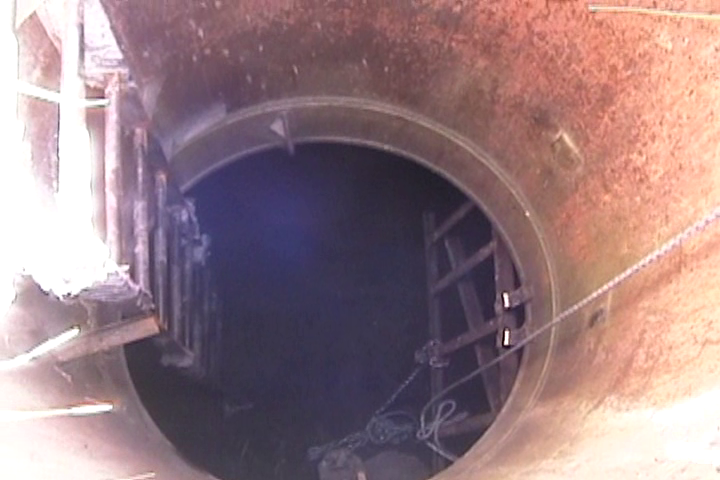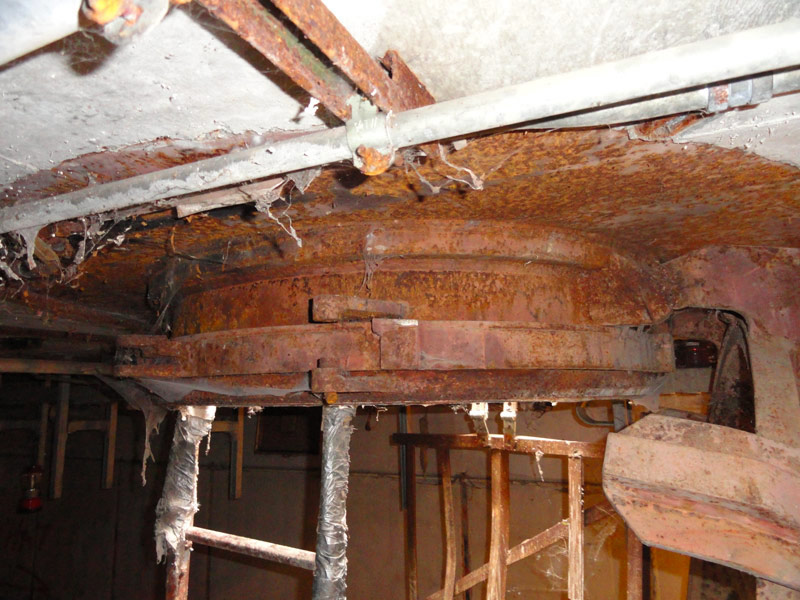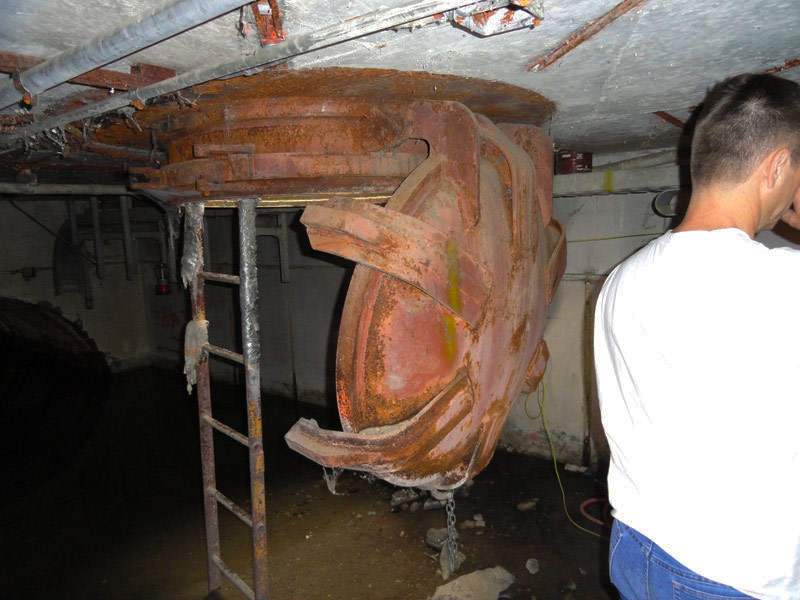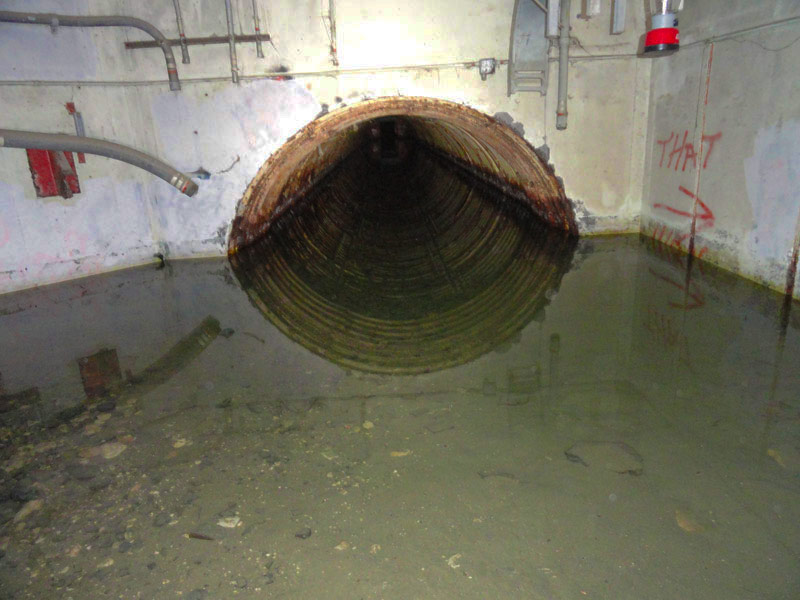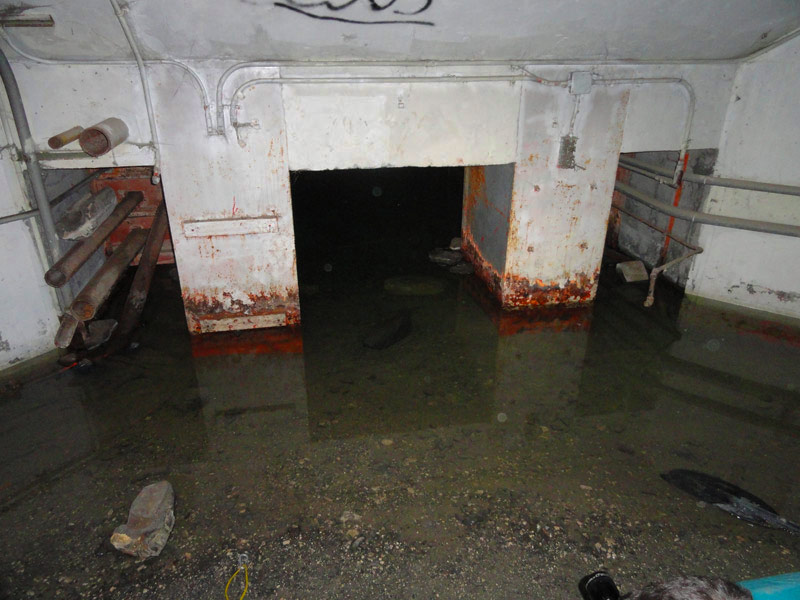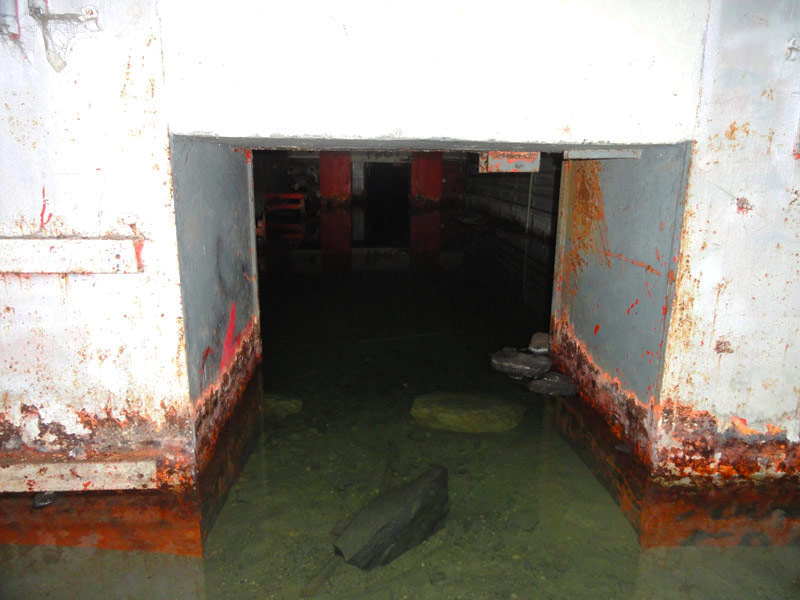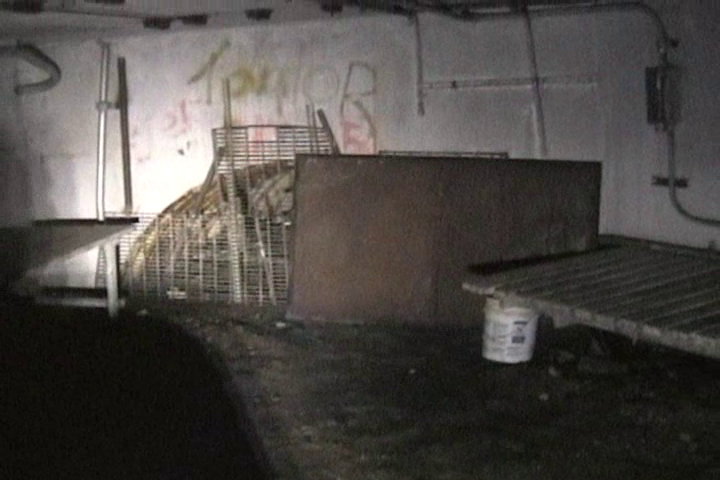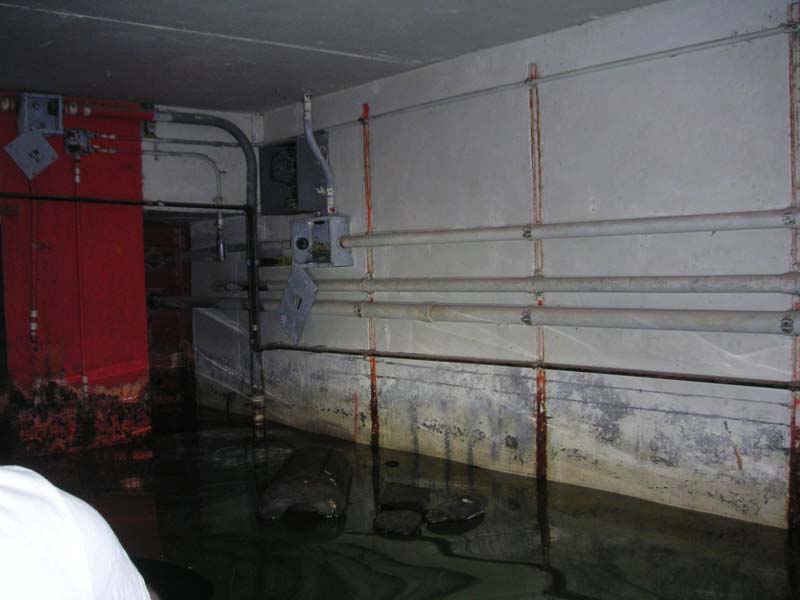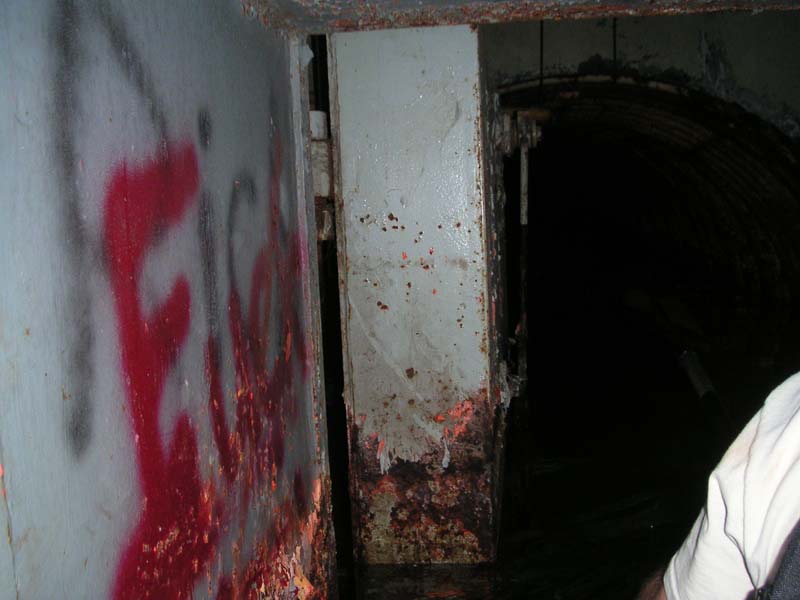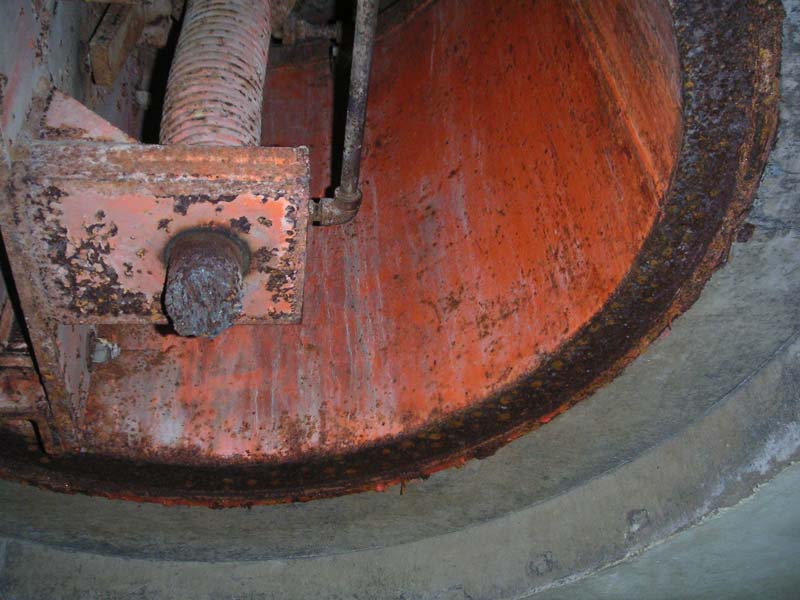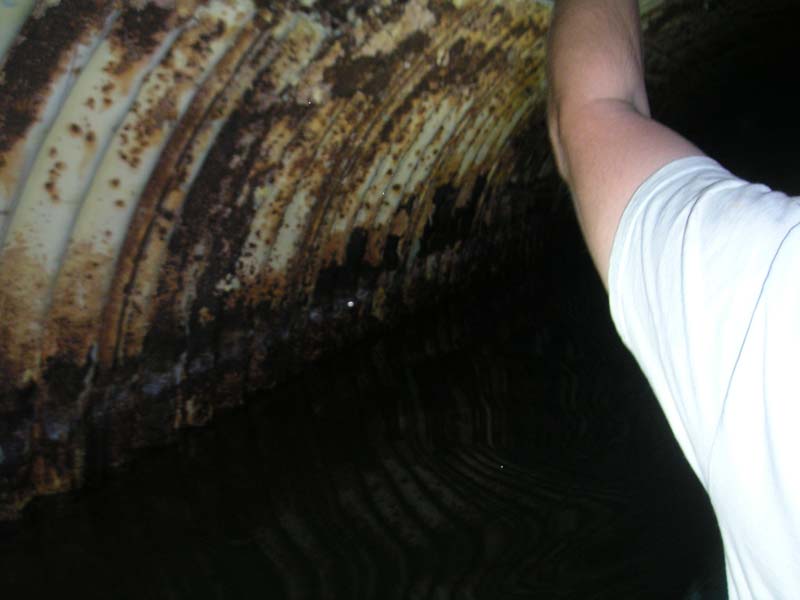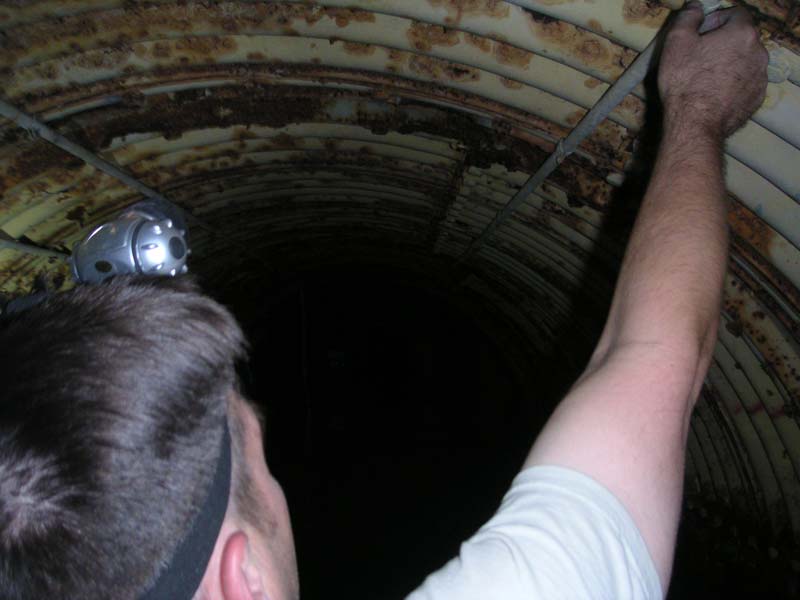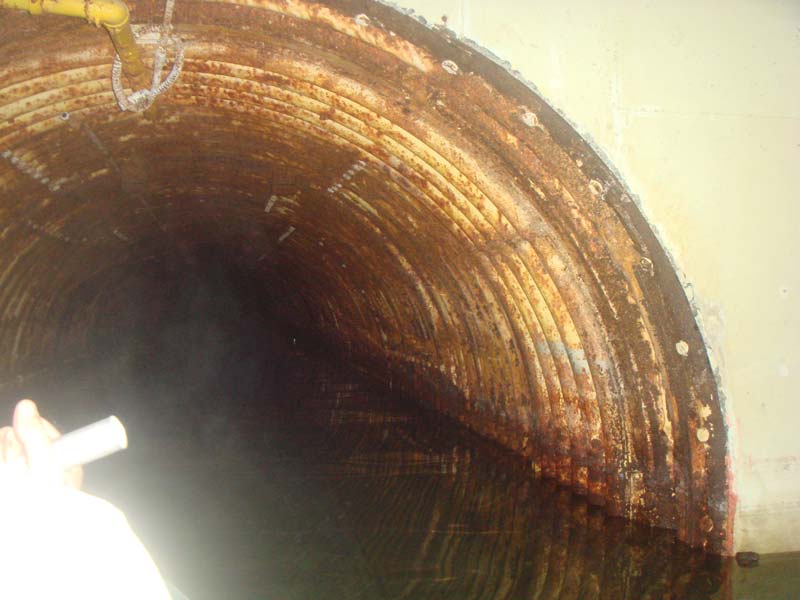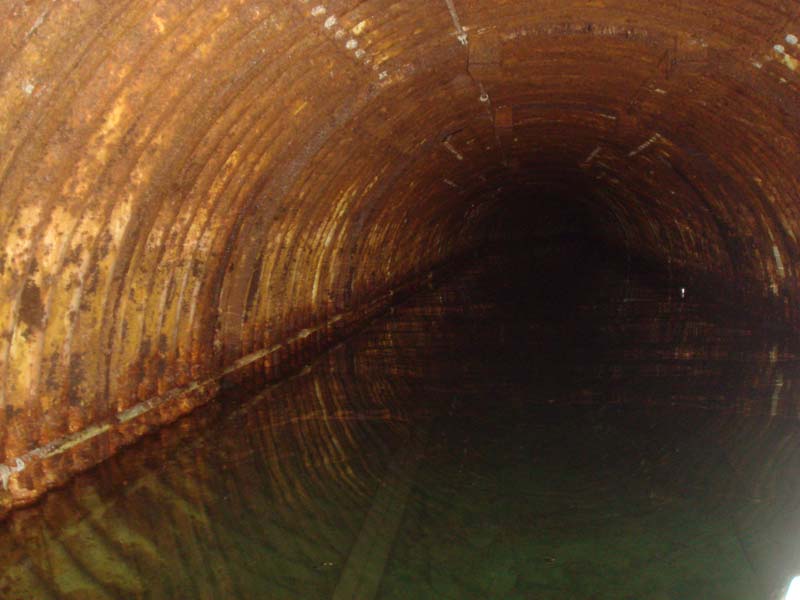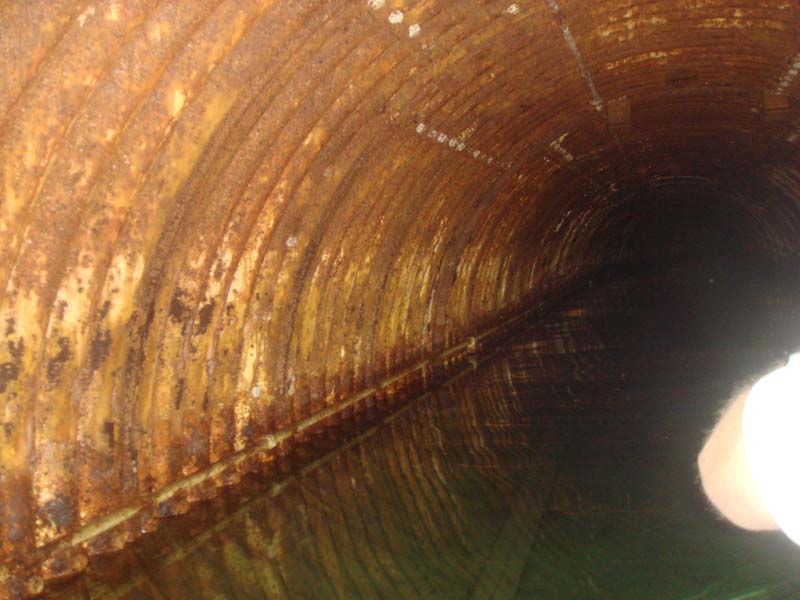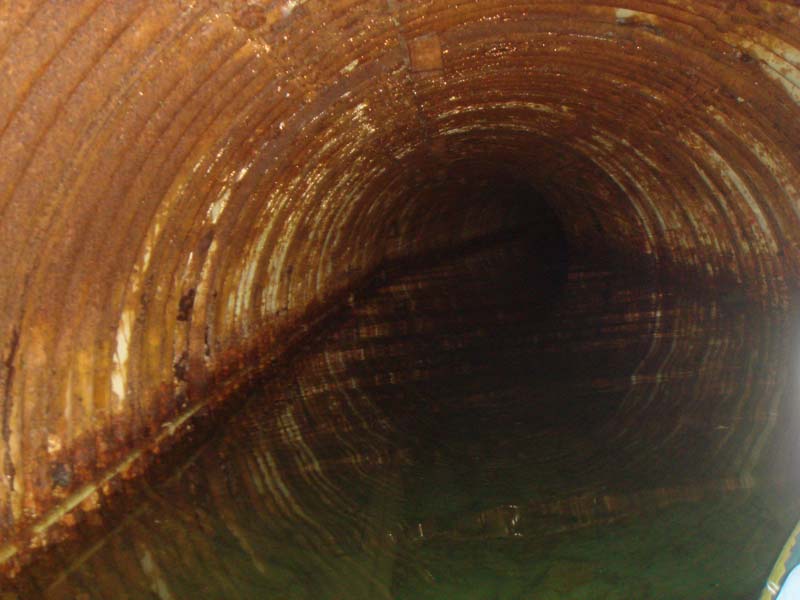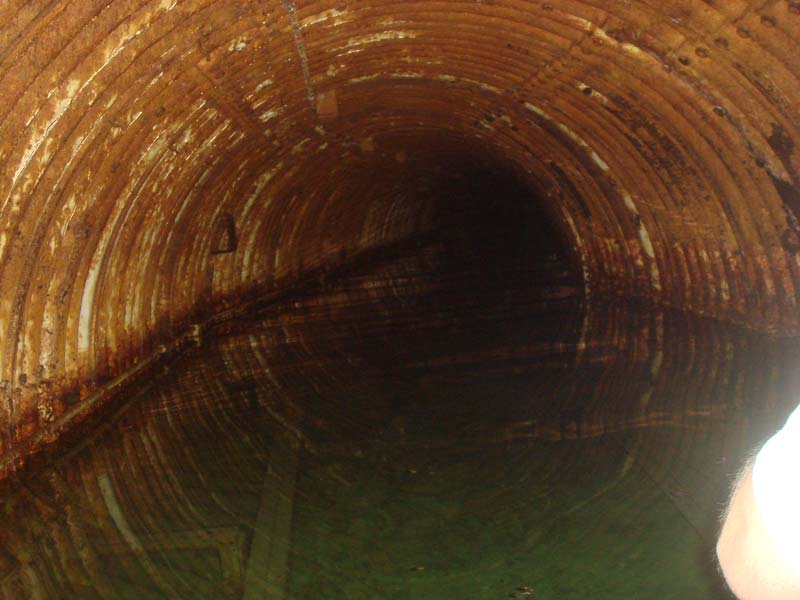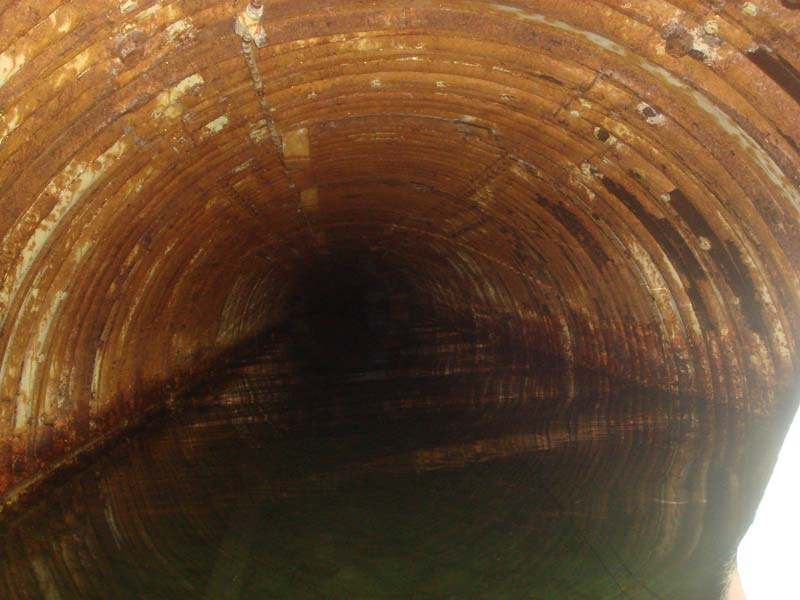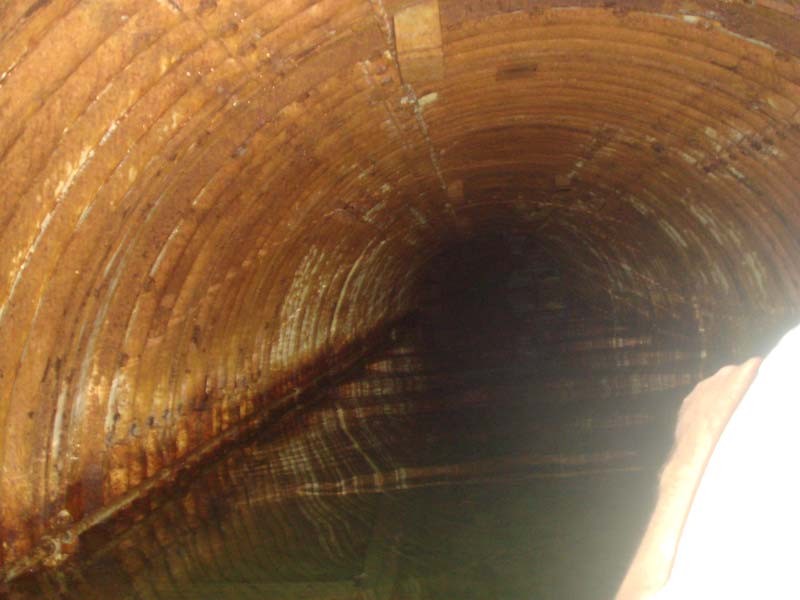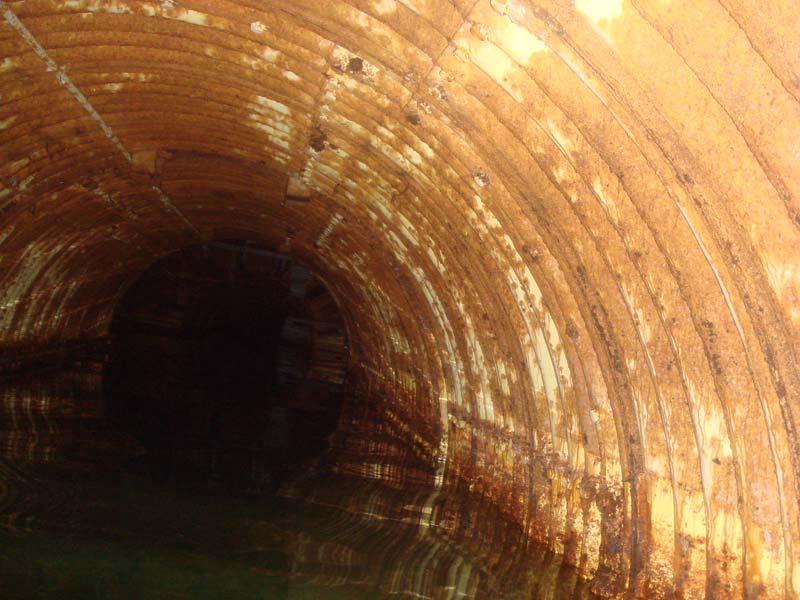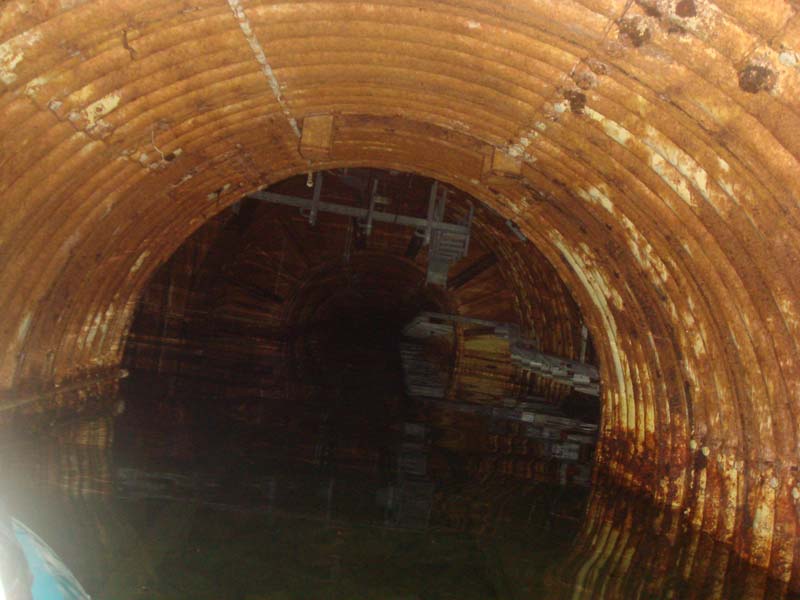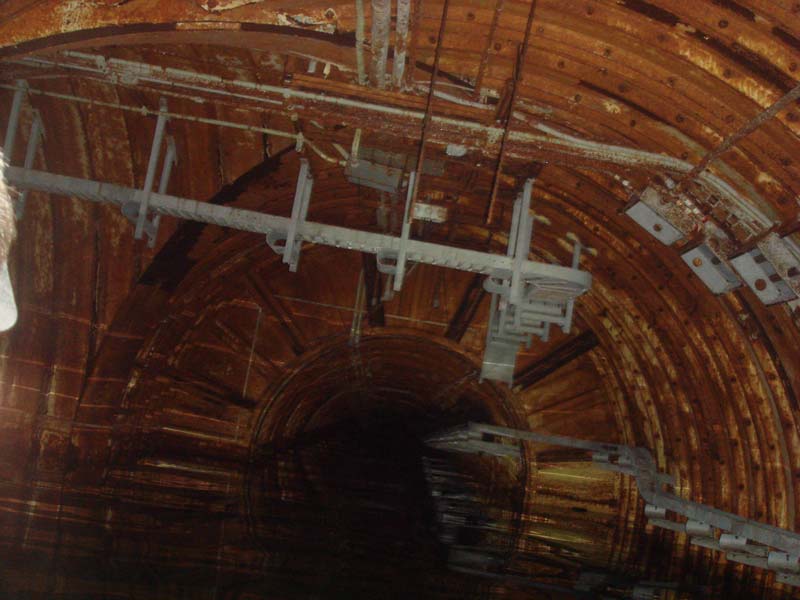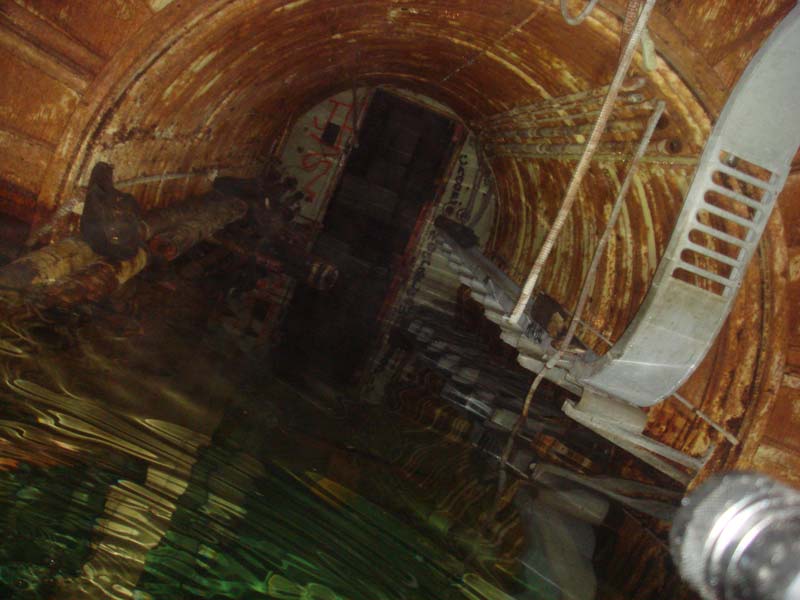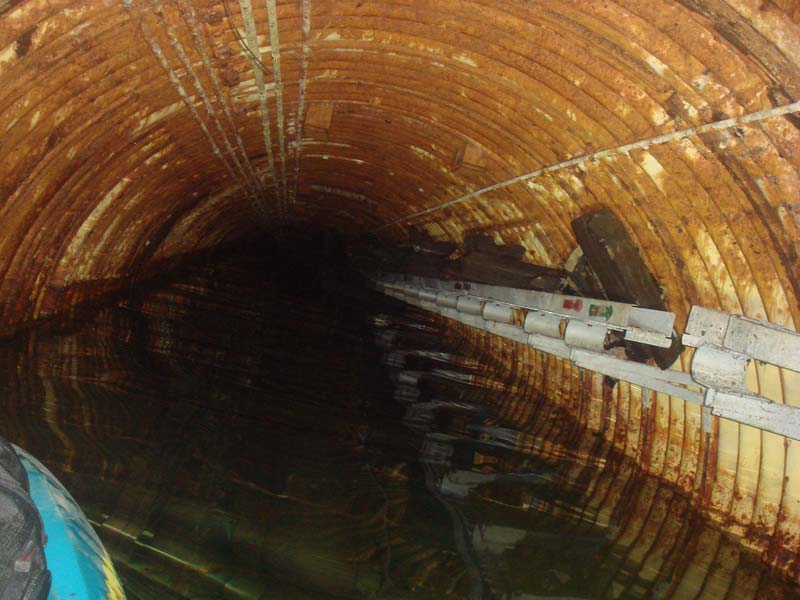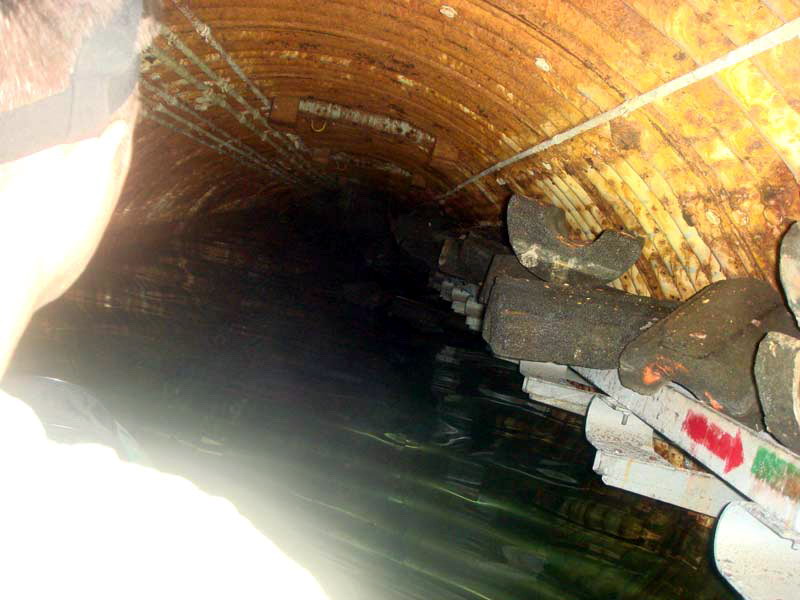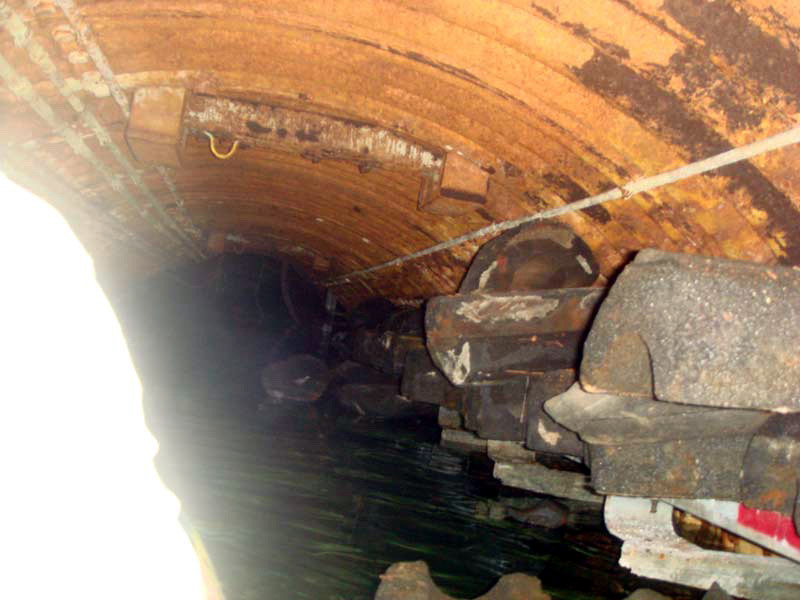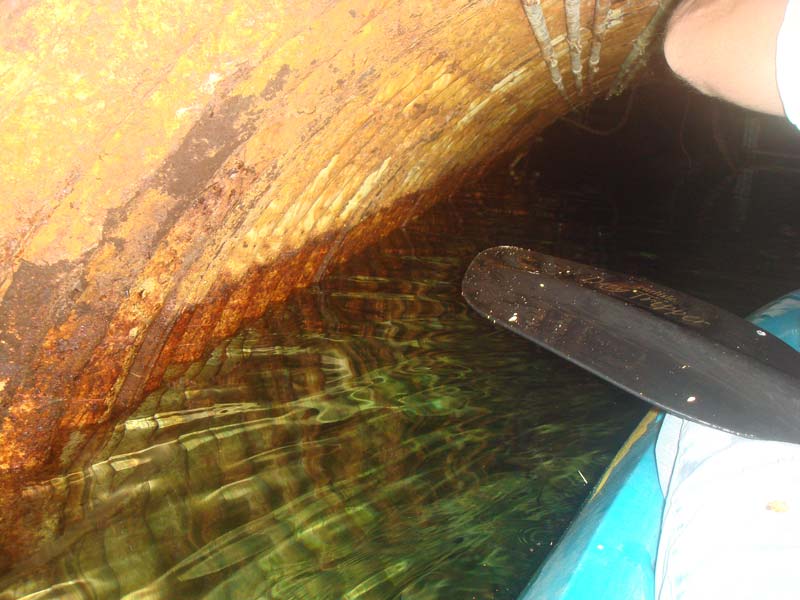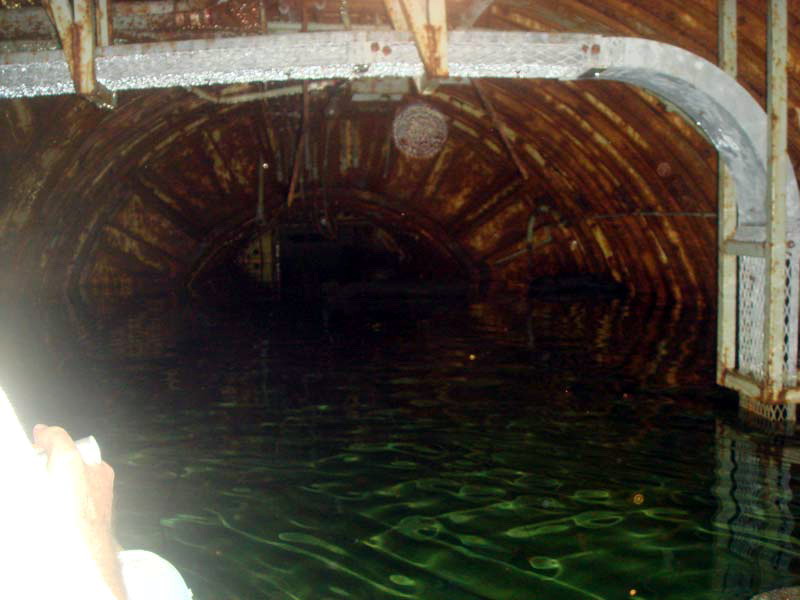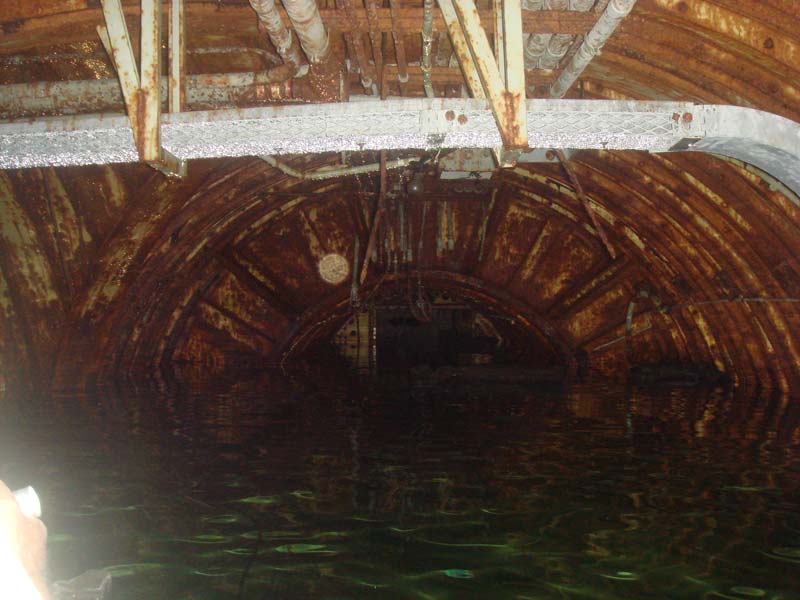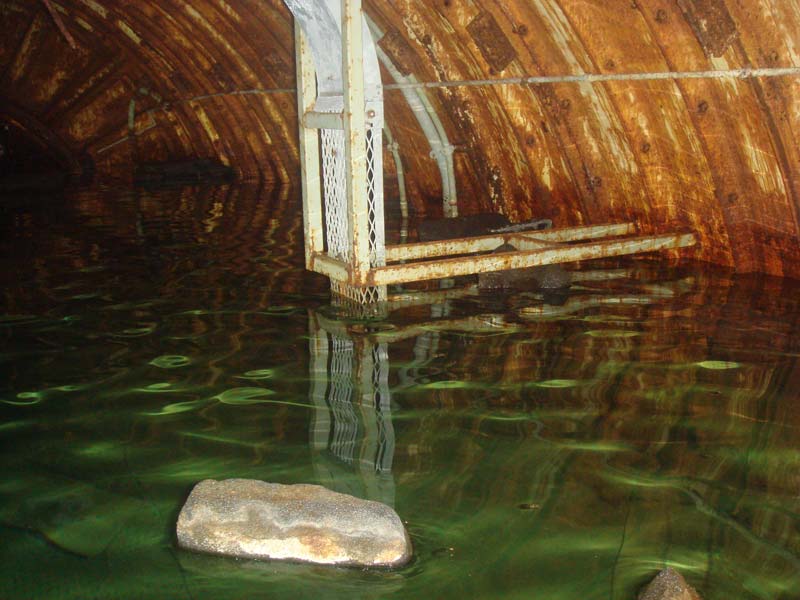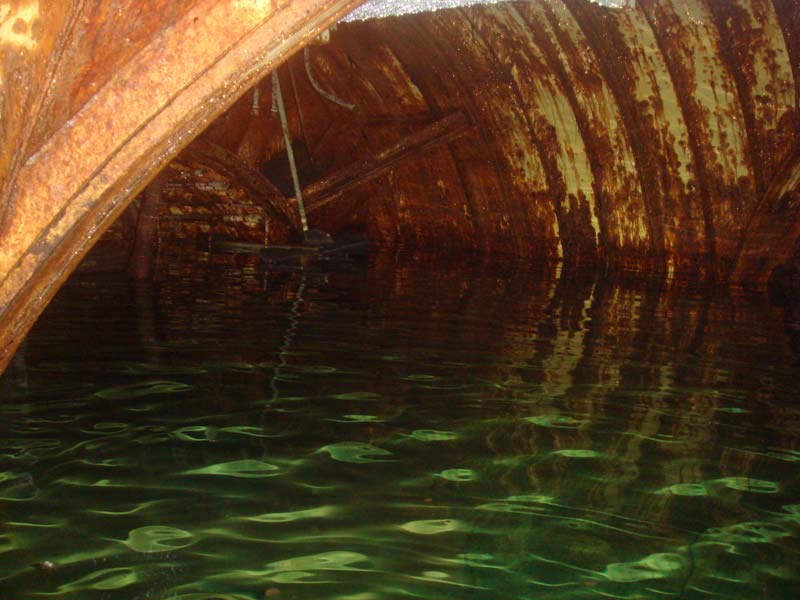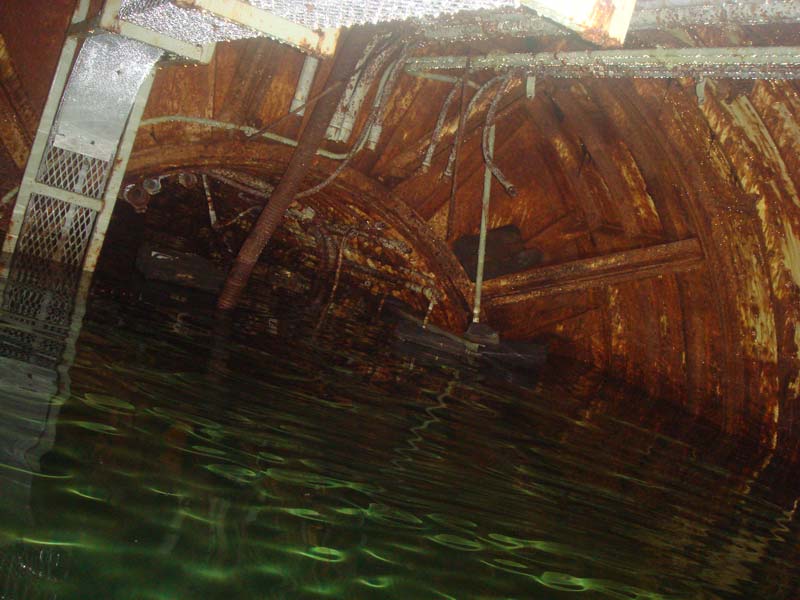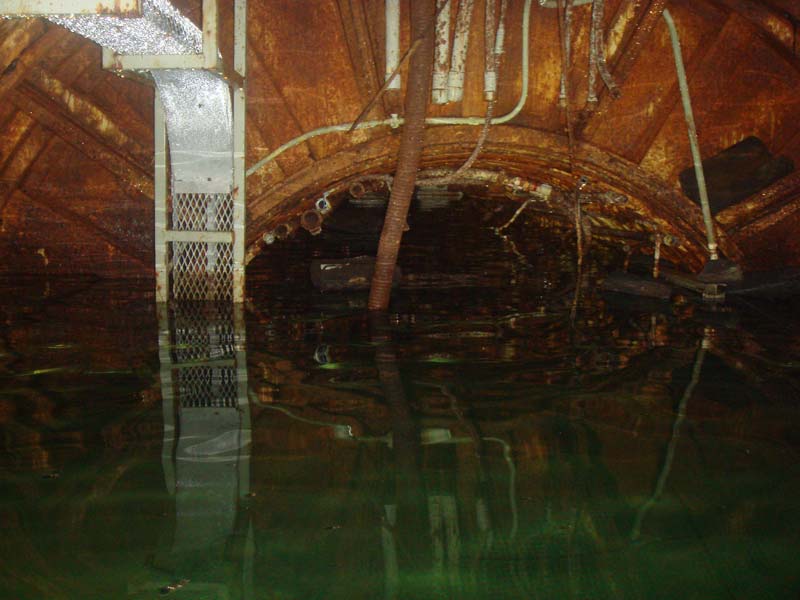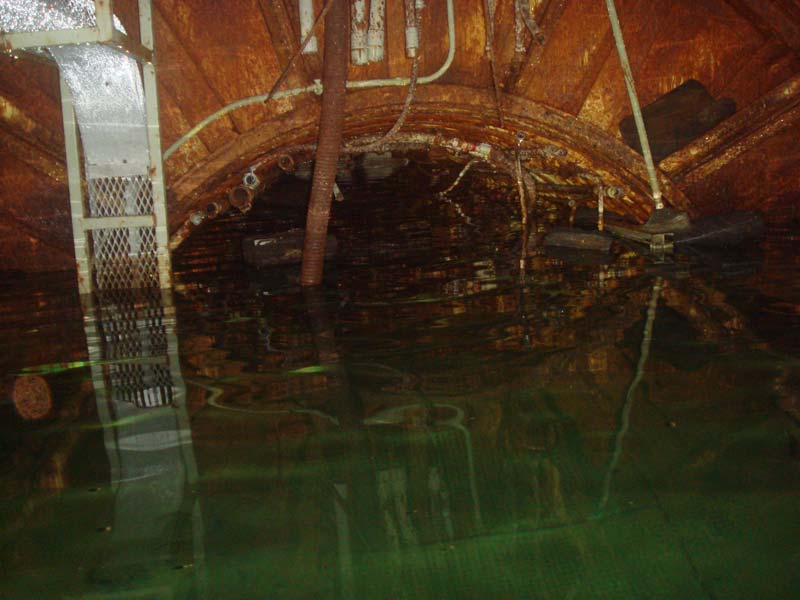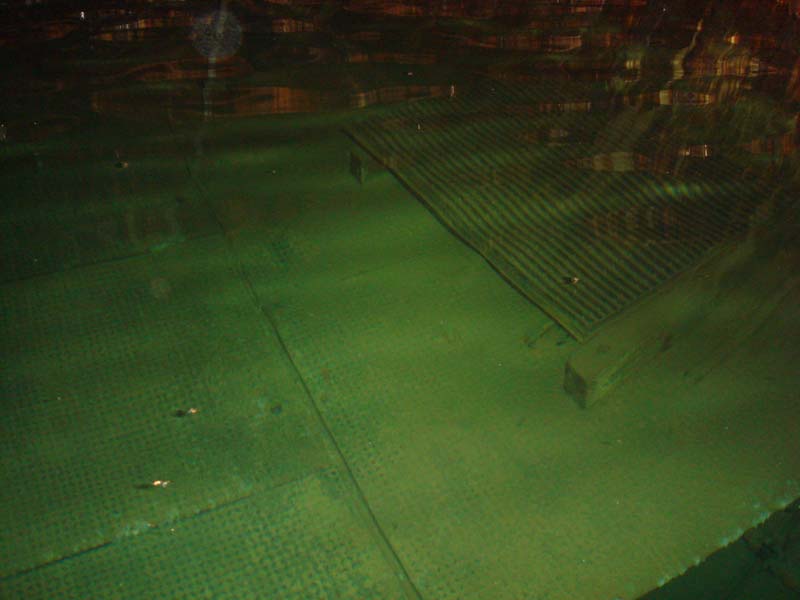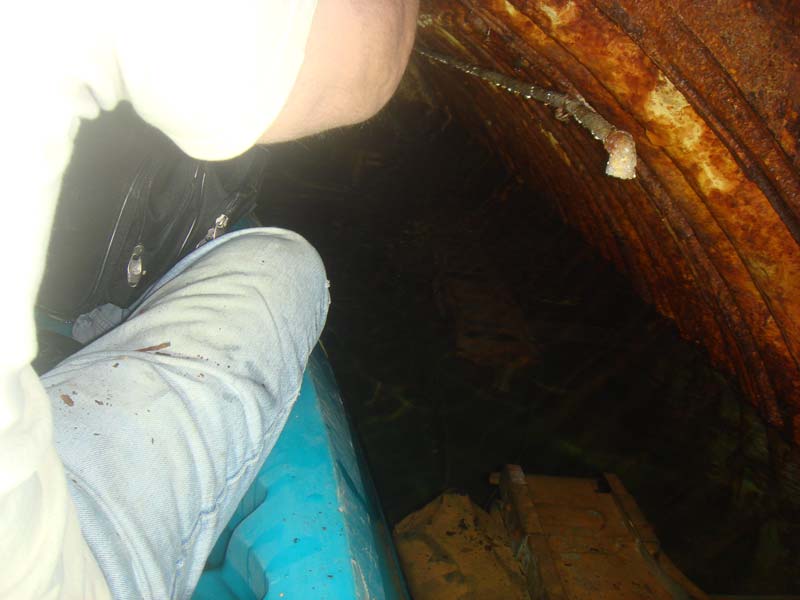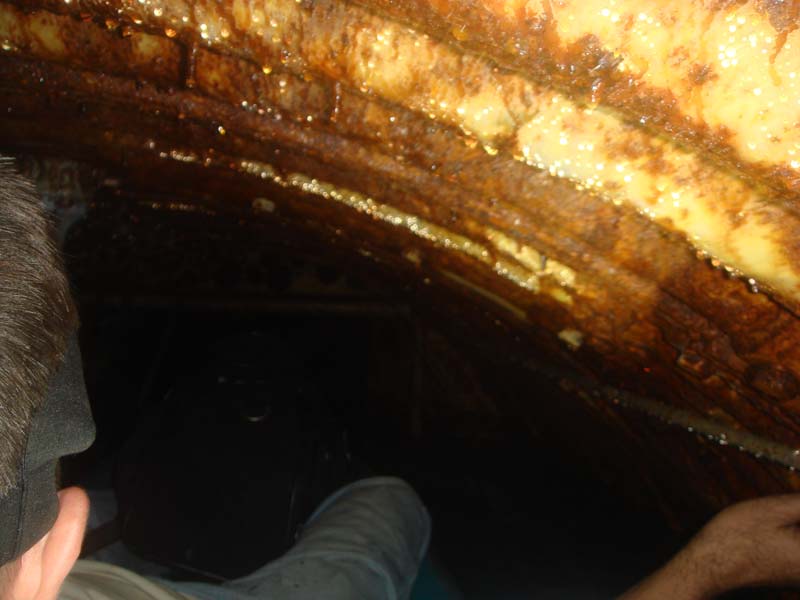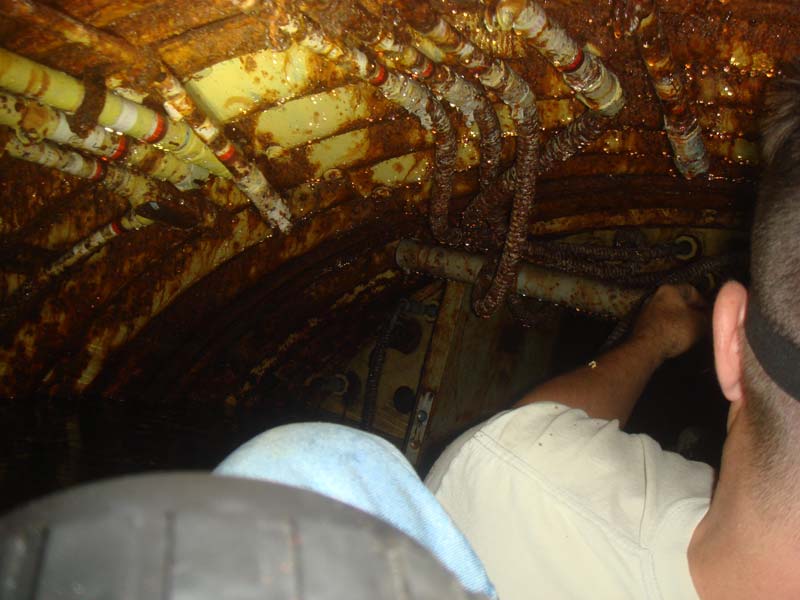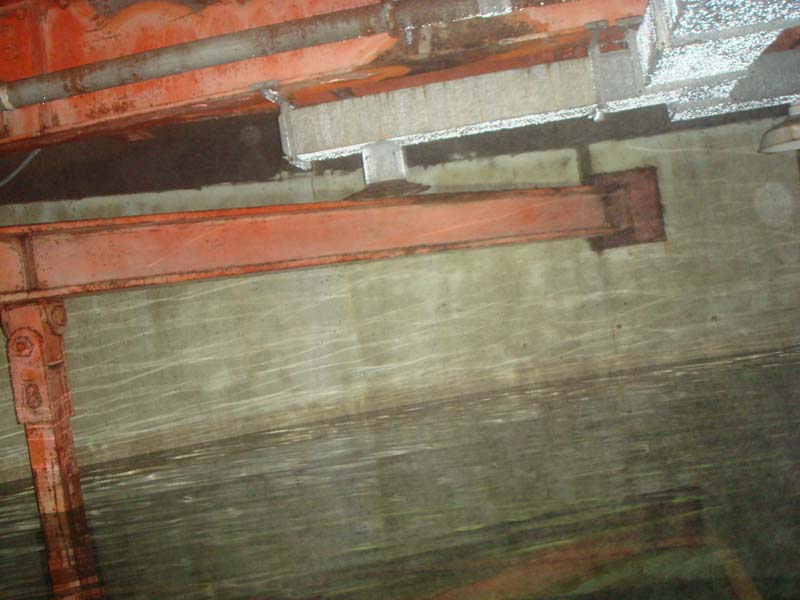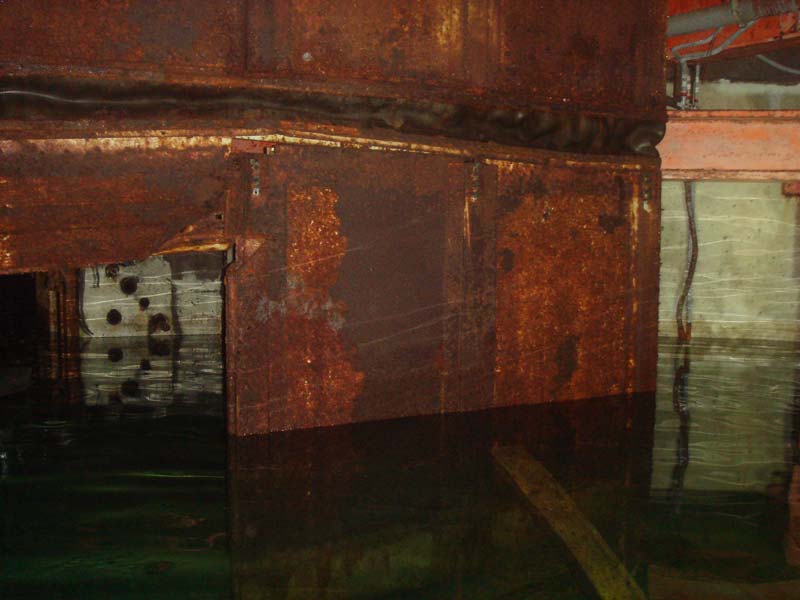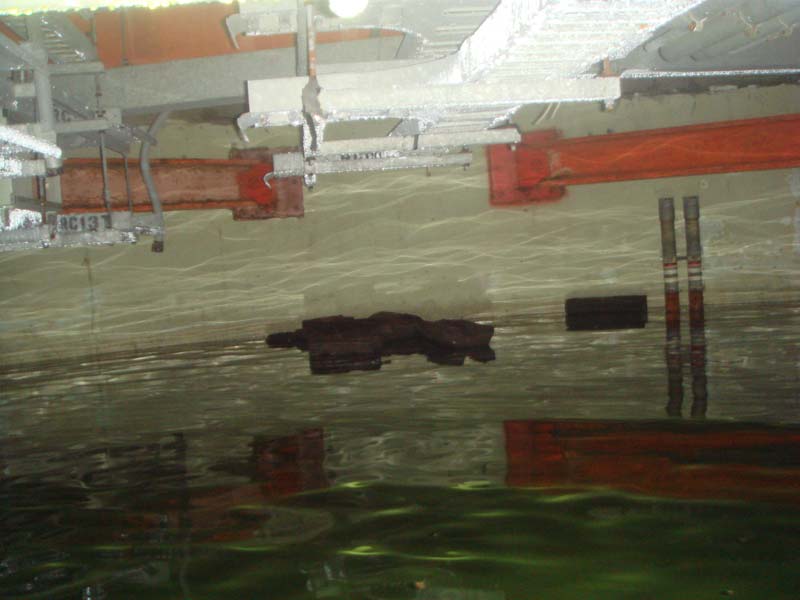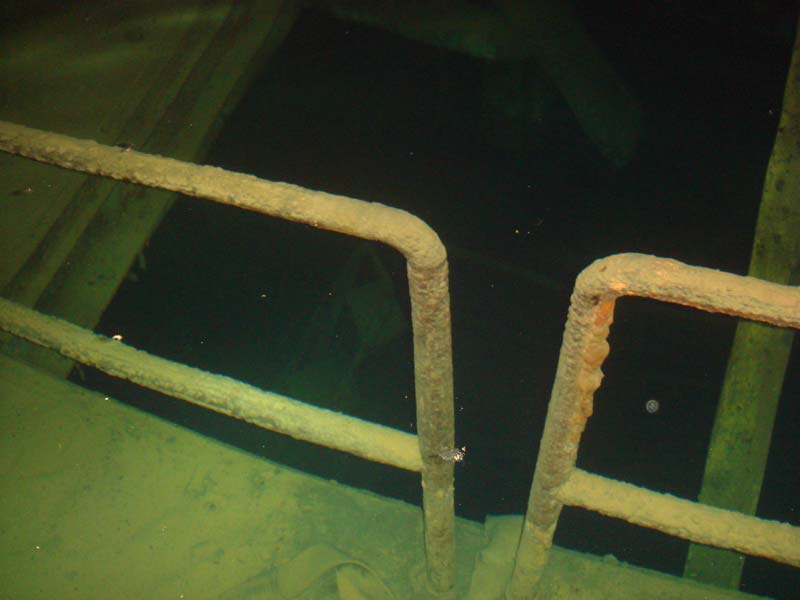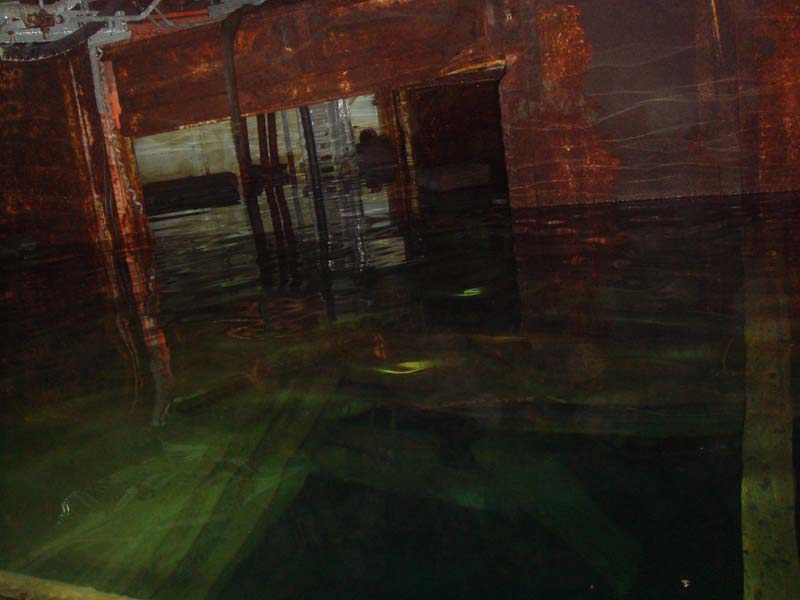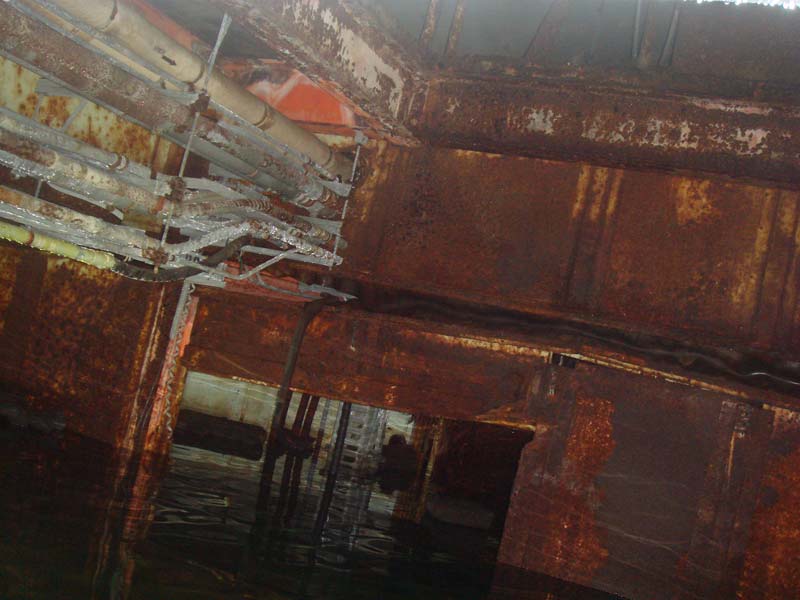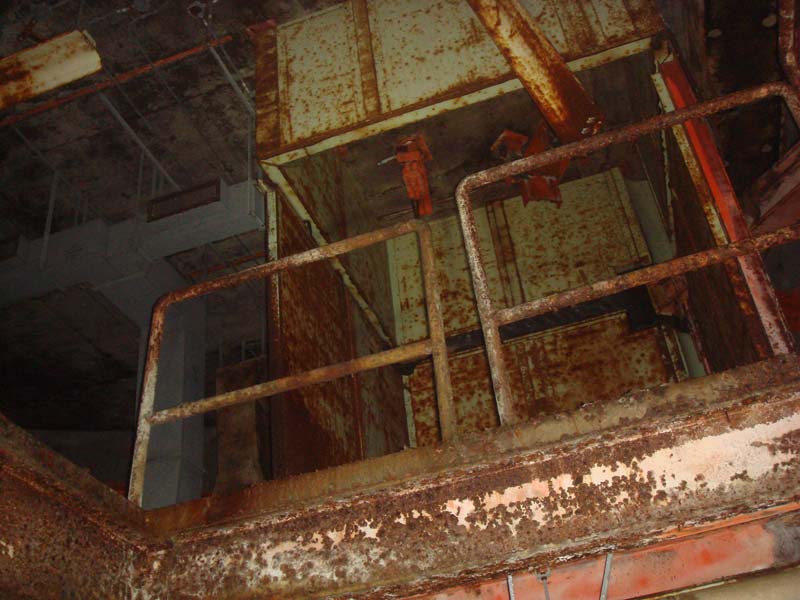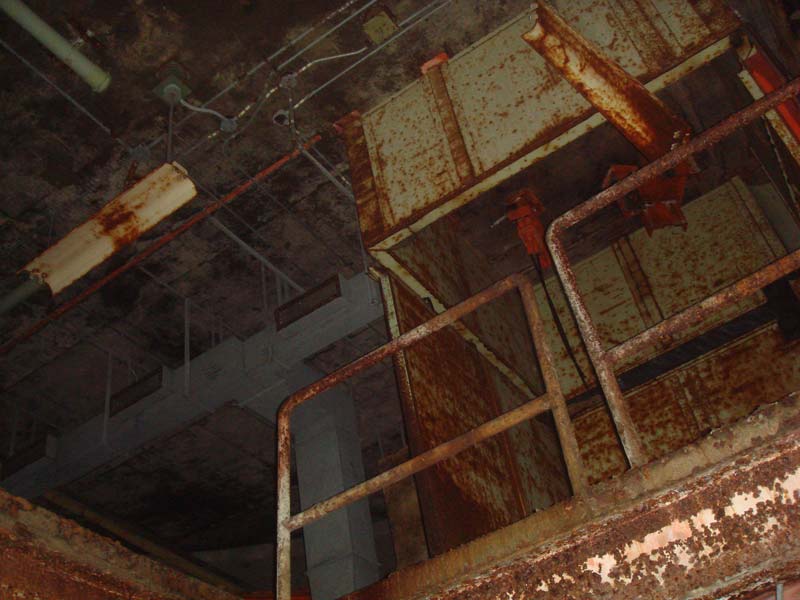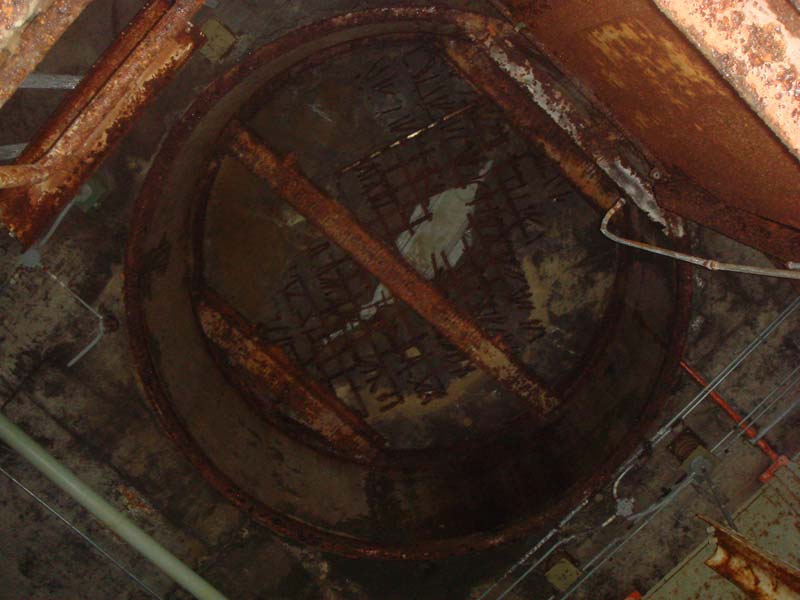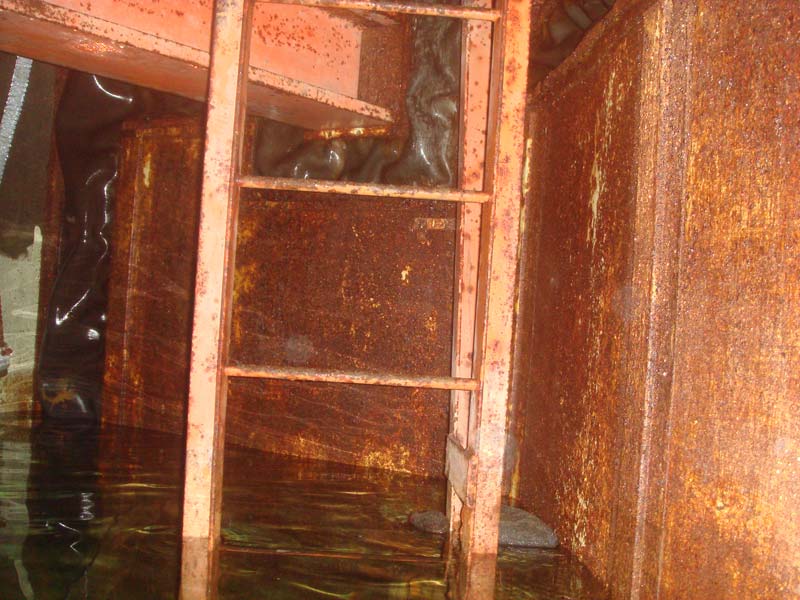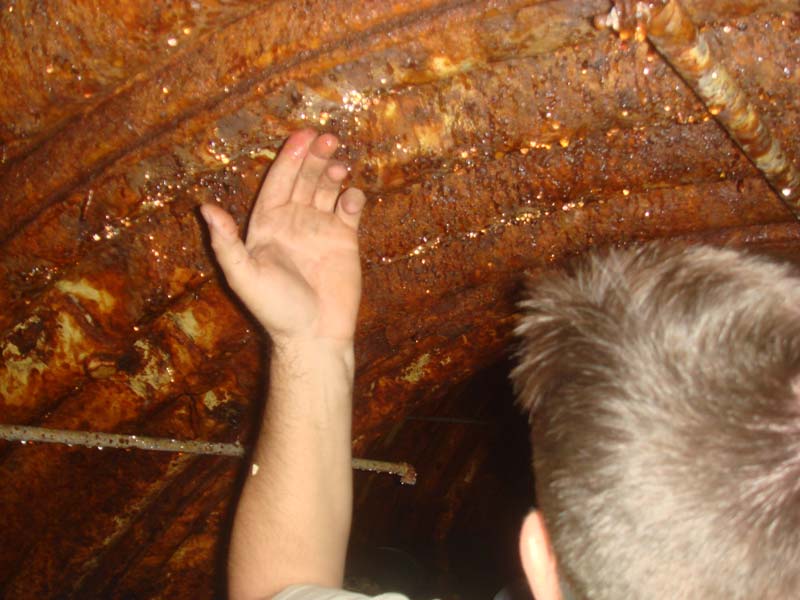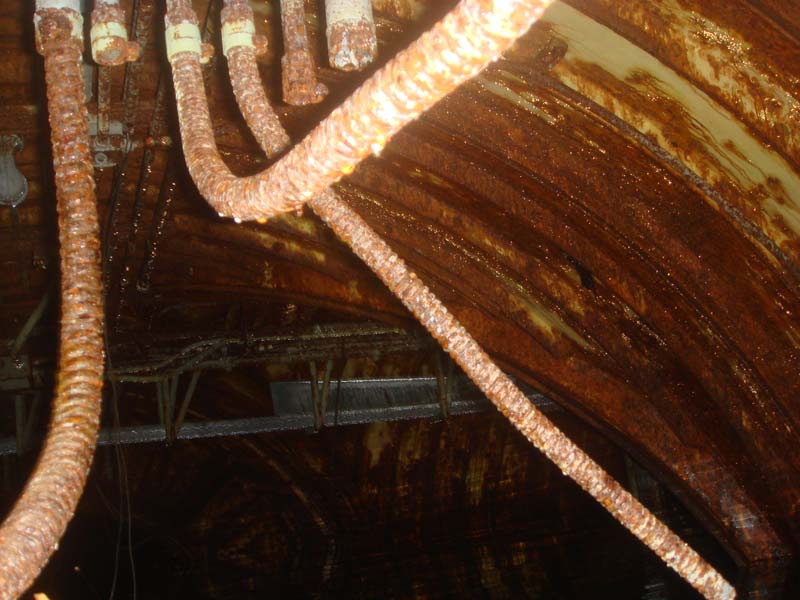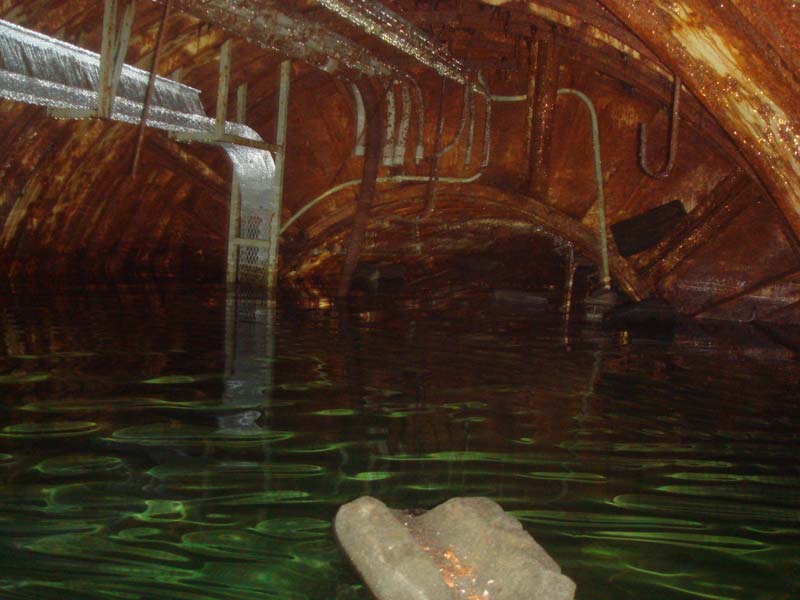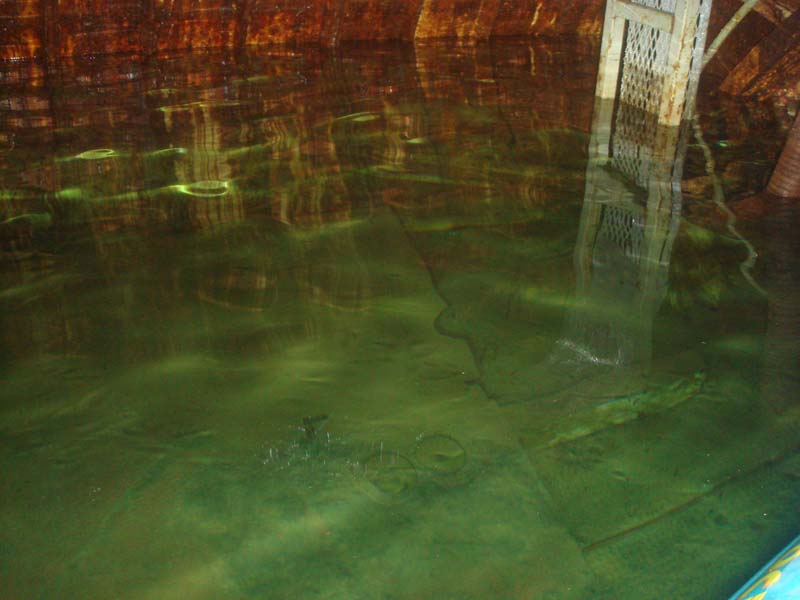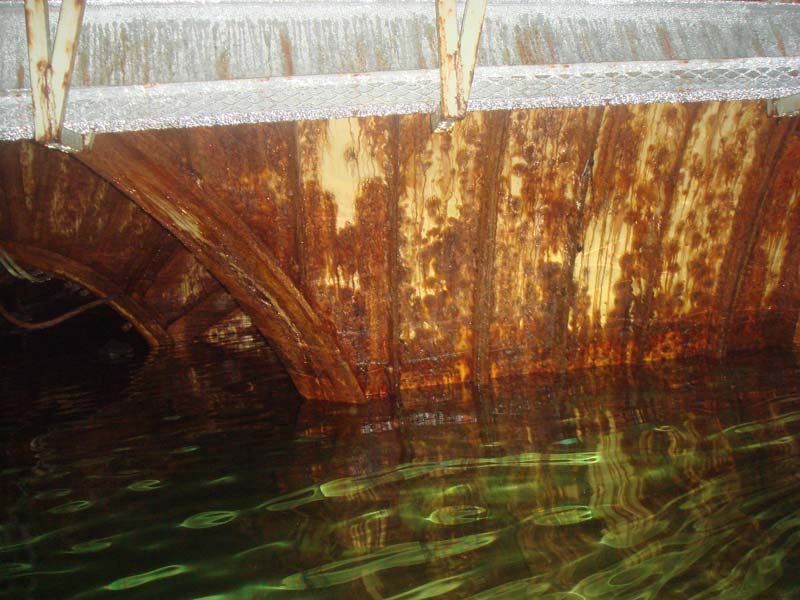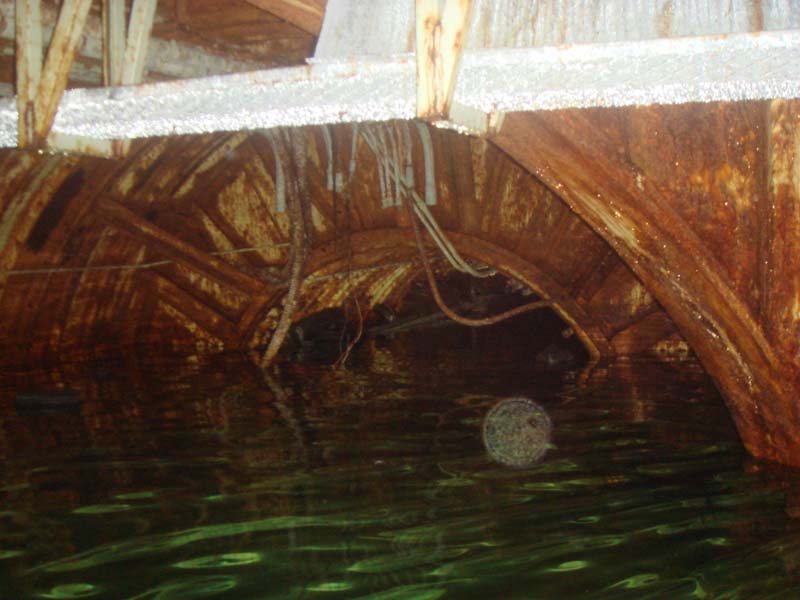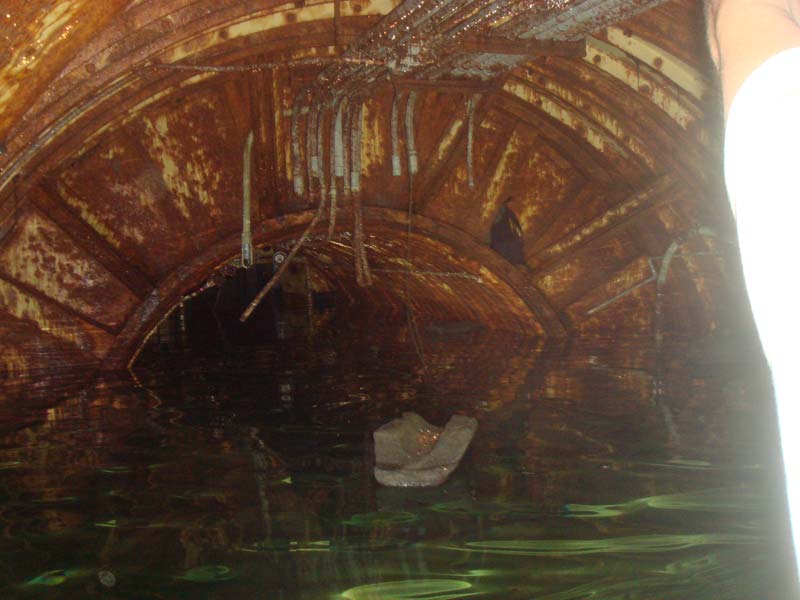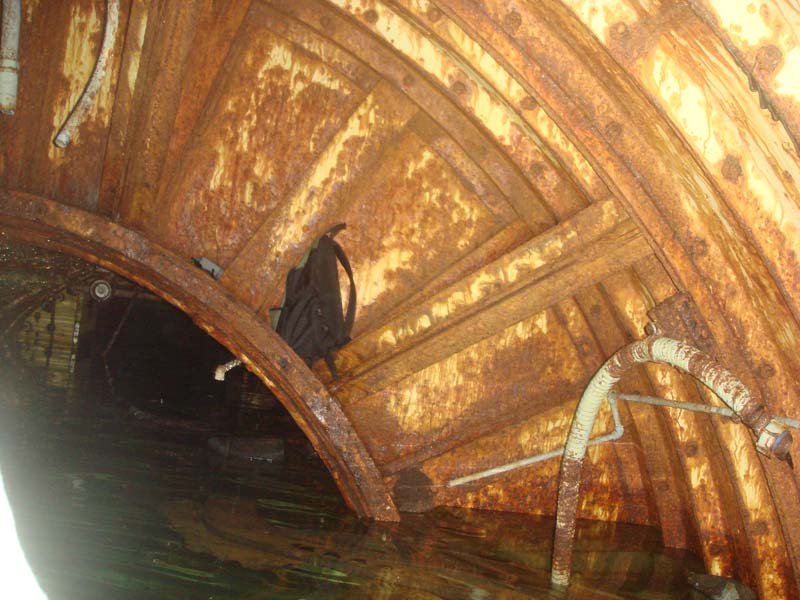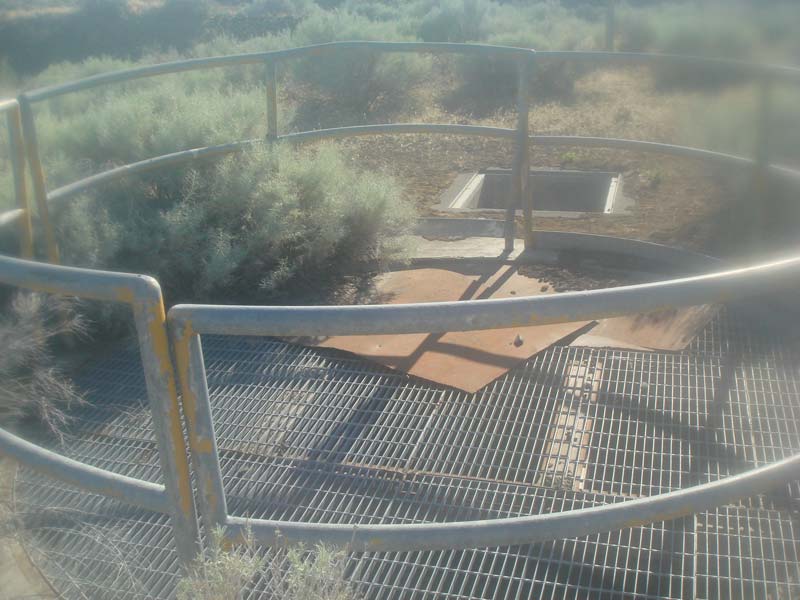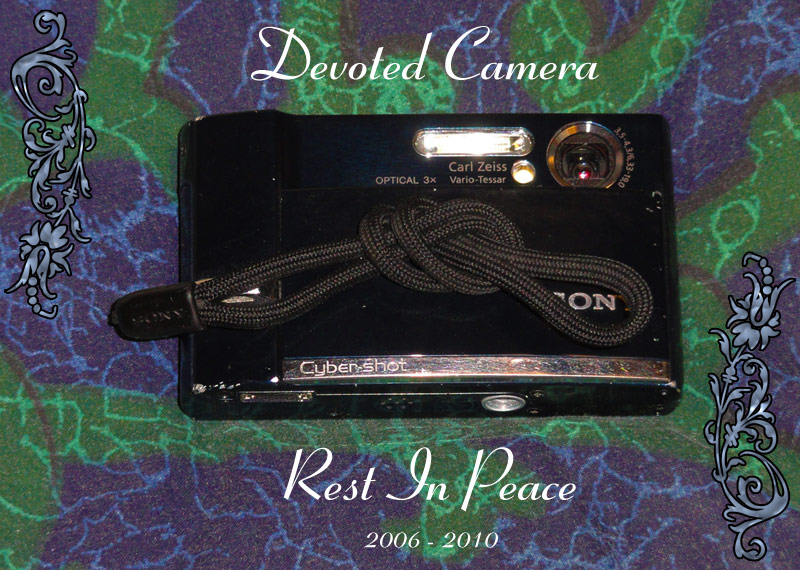
|
||||||||||||||||||||||
|
This Adventure:
_____________
Part 08 _____________
|
||||||||||||||||||||||
|
The Same Deep Water as You Eager as always, Walter was down the ladder in a flash and disappeared from view. The others had donned their wetsuits and lit out for the silos ahead of us since we wouldn't be diving. This left us free to explore to our hearts' content. Our excitement was palpable as we looked about the blast lock where we stood with tunnels leading off in three directions. There was about seven feet of sand and silt covering the floor, washed in by the waters that flooded the complex. One of the tunnels was blocked by heavy steel welded securely in place-- the path to where Titan Creek entered through a section of ruptured tunnel. The other 2 tunnels were flooded about halfway to a depth of 4.5 feet and led off into the dark. The echoing sound of dripping water emanated from the tunnels, one leading to launcher #1 and the other to blast lock #1 where it would split off to launchers #2 and #3.
A strange sound could be heard from the tunnel to launcher #1, very faint and completely alien to my ears-- a quiet rustling perhaps? No, it didn't sound right, and besides, what the hell would be rustling in there? Weird. The walls were pretty bare, just a bit of conduit here and there, no real piping or much else in the way of original features. The escape tunnel access hatch was completely different from the Lowry sites and looked like a great grasping hand with 5 giant fingers to hold the tunnel securely closed. When closed, a hydraulic cylinder rotated a locking ring that securely sealed the shaft to the surface. It looked like quite a solid design indeed! The Undersea Adventures folks had built a sort of staging area there in the blast lock consisting of a wooden platform /bench and table where divers could prepare and get suited up. A few gas lanterns were hanging from conduit as backup lighting.
A punctured inflatable raft lay sad and limp at our feet next to a blue kayak-- our primary means of intended locomotion through the watery canals that led to the silos and tunnels beyond. A single paddle lay nearby, a second paddle could not be found, hmmm.
After a few photos and readying my gear and doing my best to try and ensure none of it met a watery end in the flooded areas of the complex, we were ready to embark on our watery Titan I adventure.
We decided to head down the tunnel to launchers #2 and #3 first and moved the rather light kayak to the sandy "beach" near the mouth of the tunnel. On closer inspection, the kayak did not enclose the rider from the waist down within its plastic body as many do, rather, it sported several vaguely butt-shaped depressions within which 1 to 3 people could sit. I have since learned this is known simply as a sit-on-top tandem kayak.
While I clearly know little about kayaks, as I looked at this foamed-filled flotation vehicle, one thing was quite clear: our asses were going to get soaking wet! The expectation that you will ride over water in a craft such as a kayak without getting all wet is an introduction to folly. Even so, we thought we could pull it off... that is until we noticed that the kayak was full of holes.
By design, the kayak was "vented" having a series of holes that passed through its body to allow water to drain off the top should it get submerged. Unfortunately it also allows water to well up from below when you get in which totally swamps your ass (as we soon found out) with cold water. It was suddenly clear that we were going to get wet on this ride. Carefully we mounted the precarious watercraft (we still had to at least try to keep the cameras dry) one at a time, trying our damnedest not to capsize it.
Walter pushed us off the silty beach near the blast door to launchers #2 and #3. I did my best to help despite not having a paddle by pushing against the walls and pulling us forward using conduit or anything else I could grab onto.
We drifted along on the still, clear water though blast lock #2 and emerged into the narrower personnel tunnel beyond. Save for the sound of the kayak paddle gently splashing in the water, it was completely silent in the dark, rust-flaked tunnels.
We were continually surprised at the clarity of the water; the bottom of the tunnel was clearly visible in the flooded areas.
Succumbing to the Moistness The tunnel to blast lock #1 stretched on and on as we shattered the perfect, flat plane of water on which we sailed, sending out soft ripples that dashed ahead of us up the tunnel, disappearing into the blackness beyond. By this time, any hope of staying dry from our asses on down to our feet were soundly dashed as the water leapt up from below and through the holes in our humble craft and filled every dent, depression, crevice and concavity, including the ones in which we were sitting. The Moistness was upon us and and there was nothing to be done about it, uncomfortable as it was. Before leaving the poisoned agricultural lands of Iowa I had foreseen the need for waterproof footwear and had gone so far as to purchase a brand-new pair of waterproof waders with which to brave the damp depths of the complex. Sadly, I had neglected to don said waterproof apparel, thus rendering it useless.
Furthermore, I had gone through all the trouble of packing the bulky damned things in my luggage (which the TSA gleefully rifled through, and subsequently did a sorry job of re-packing) which I would liken to a small or mid-sized boat anchor which I was cursed to lug about everywhere I went for no good reason.
Launcher #2 brought a heightened excitement as I knew we were close to the cribwork! Rare and hard to get access to, I had been dreaming of the day I would see it firsthand for over a decade. I had heard it existed at some sites, I had seen some pictures and I had even posted entire sections on this site showing photos of the cribwork, but still, I had yet to see it for myself. Had I not been soggy from the kayak, I might have broke out in a sweat. Unable to wait any further, we passed up the propellant terminal and headed for launcher silo #2 where rusty pipe and conduit closed in menacingly as we approached.
As we sailed silently into the tunnel junction between the silo and equipment terminal, it was clear the water level had gone up, or rather, the tunnel had gone down. The relative elevations of the various tunnels, terminals and other features varies from one location to another. The tunnels that usually appear level are in fact sloping upward or downward depending on where you are and which direction you are facing. This particular length of tunnel had been sloping downward disconcertingly as we neared the tunnel junction.
Eyeing the tunnels leading into the silo and equipment terminal, it was clear that there was very little room to squeeze through without diving under the water-- something we were not keen to do without a wetsuit. We sized up the tunnels as we floated about the junction, trying to see if we could fit through the small gaps. I stowed my camera gear to prevent inadvertent dunking and held my bag of gear to my chest.
Cautiously we approached the silo tunnel, both of us hoping we could slip through the claustrophobic gap, but as we got closer, our optimism took leave of us. We tried laying flat against the kayak to fit through the opening and slowly edged forward. "There is no way we're going to fit through there", Walter groaned as a shower of crimson rust flakes rained down on us both forcing our eyes tightly closed as we brushed the top of the tunnel. Thwarted and cursing, we backed awkwardly from the tunnel. We were not getting through there without going under. The nearby floating corpse of a mouse confirmed I wasn't prepared to do that. Yuck! We decided to try our hands at the equipment terminal which appeared to have a bit more clearance than the silo entrance and Walter steered us over to the opening where once again we laid flat and pulled ourselves forward using whatever rusty bits of metal we could grab.
A tight squeeze, no question, but all in all, we had little trouble getting through the narrow constriction and were soon cavorting (metaphorically of course) about the equipment terminal.
There was, unfortunately, not much left to see on the upper levels. Anything of great interest that might have remained was hidden under the dark depths of the 2 and a half flooded levels that concealed anything I could imagine might be down there.
Back in the tunnel junction, the silo entrance taunted us but we knew there were two more silos and resisted (just barely) the urge to dive under that cold, dark water to see the hidden silo beyond. The desire was almost consuming and it were it not for the terrible aversion we harbored over the water and its dreadful mystery we might well have. As it was, the two other silos beckoned and we turned about, heading back the way we had come with renewed enthusiasm.
Death on the Silo On the way back, we made what was for me, a fateful stop at the propellant terminal which involved laying flat once more in order to fit through the very small opening of he flooded tunnel. Once inside, I took some video of the interior, all the while completely unaware of the misfortune which had befallen me. We were faced by the same tight squeeze as we had seen at silo #2 only just a bit easier to pass through. As we went to leave, I turned on my camera to take a few more shots and discovered water dripping from it. Oh dear... I tried to take a photo, but the usual display and simulated shutter sounds were silent. I opened the battery compartment and cursed vigorously as I found more water inside. My camera, it was no more. It was clear that when I'd ducked under the tunnel opening to enter the propellant terminal, the camera, which was held to my wrist by a flimsy strap, had gotten thoroughly dunked as we entered. I tried to take a photo but when I looked at the result, this is what I saw: I tried my soggy camera again. Only the faintest hint of the scene could be discerned amidst the murky image that resulted. I had failed in my duty to protect my camera-- the same camera I had brought back with me from Japan after lying to customs agents about buying it there to sidestep fees. We headed back outside to get some water and warm up a bit before heading to the other 2 launchers and I did my best to let my camera dry out in the sun in hopes of reviving it. It didn't work. Hours later I took the following photo: The results were not encouraging. The flash no longer worked, no doubt having fried itself with its own high voltage charge, and the image had taken on a permanent ghostly fog probably thanks to deposits left on the CCD by the water. CRAP!!! I was forced to switch to my smaller, crappier camera for the remainder of the trip, including 568-A-- a whole different Titan I site. Not good. The camera was purchased in Den-Den town (aka: Nipponbashi), Osaka's sprawling consumer electronics marketplace and faithfully took over 5000 photos in and around Osaka, Nishinomiya, Tokyo, Kyoto, Kobe, Himeji, and the volcanic wonderland of Beppu on the southern island of Kyushu before meeting this sad end in the waters of 568-C. It was and is deeply missed. After a brief respite topside, we dove back into the compelling and soggy underworld of Larson 568-C leaving my fallen cam-rade behind. Next stop: Launcher #3.
|
||||||||||||||||||||||

